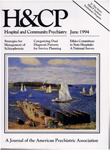Religious Affiliation and Psychiatric Disorder Among Protestant Baby Boomers
Abstract
Objective: The authors examined the relationship between religious affiliation and psychiatric disorder among Protestant members of the baby-boom generation (those born between 1945 and 1966) who resided in the Piedmont area of North Carolina. Methods: Data were obtained on six-month and lifetime rates of major psychiatric disorders among 853 Protestant baby boomers during wave II of the National Institute of Mental Health's Epidemiologic Catchment Area survey, conducted in 1983-1984. Participants were grouped into three categories based on religious affiliation: mainline Protestants, conservative Protestants, and Pentecostals. Rates of disorder were compared across denominational groups, controlling for sex, race, physical health status, and socioeconomic status and stratifying by frequency of church attendance. The analyses were repeated for 1,826 middle-aged and older Protestants born between 1889 and 1944, and the results were compared with the findings for baby boomers. Results: Among the baby boomers, Pentecostals had significantly higher six-month and lifetime rates of depressive disorder, anxiety disorder, and any DSM-III disorder. Mainline Protestants had the lowest six-month and lifetime rates of anxiety disorder and the lowest six-month rates of any DSM-lll disorder, whereas conservative Protestants had the lowest six-month and lifetime rates of depressive disorder and the lowest lifetime rates of any DSM-111 disorder. These relationships among baby boomers were weaker among middle-aged and older Protestants, although a new association with alcohol abuse or dependence emerged among older Pentecostals. When analyses were stratified by frequency of church attendance, associations between psychiatric disorder and Pentecostal affiliation were strongest among infrequent churchgoers, a group also unlikely to seek help from mental health professionals. Conclusions: Young adult Pentecostals in the Piedmont area experienced high rates of psychiatric disorder, which was not generally true for Pentecostals who were middle aged or older. Infrequent churchgoers appeared to be at greatest risk, although they seldom sought professional help for their problems.
Access content
To read the fulltext, please use one of the options below to sign in or purchase access.- Personal login
- Institutional Login
- Sign in via OpenAthens
- Register for access
-
Please login/register if you wish to pair your device and check access availability.
Not a subscriber?
PsychiatryOnline subscription options offer access to the DSM-5 library, books, journals, CME, and patient resources. This all-in-one virtual library provides psychiatrists and mental health professionals with key resources for diagnosis, treatment, research, and professional development.
Need more help? PsychiatryOnline Customer Service may be reached by emailing [email protected] or by calling 800-368-5777 (in the U.S.) or 703-907-7322 (outside the U.S.).



